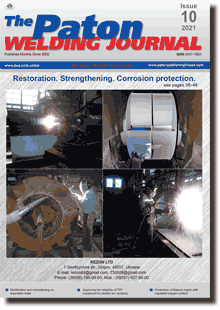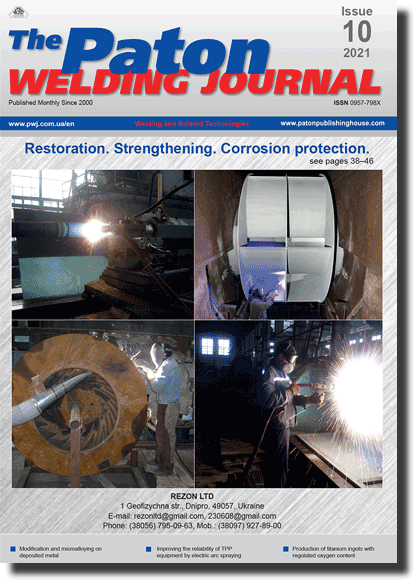| 2021 №10 (08) |
DOI of Article 10.37434/tpwj2021.10.01 |
2021 №10 (02) |

The Paton Welding Journal, 2021, #10, 3-10 pages
Influence of modification and microalloying on deposited metal structure and properties (Review)
A.A. Babinets and I.O. Ryabtsev
E.O. Paton Electric Welding Institute of the NASU. 11 Kazymyr Malevych Str., 03150, Kyiv, Ukraine. E-mail: office@paton.kiev.ua
Abstract
Proceeding from published data, the influence of modification and microalloying by boron, titanium, tungsten, zirconium, yttrium, etc., on the deposited metal structure, mechanical and service properties is shown. It is demonstrated that addition of these elements or their compounds with carbon and nitrogen in the quantity of up to 0.2 %, allows producing a fine-grained, homogeneous structure of metal, a more uniform distribution of alloying elements, that makes a positive effect on the values of strength, ductility, wear and heat resistance. It was determined that introducing small additives of boron or its compounds (in the quantity of up to 0.2 %), cerium or yttrium (in the quantity of up to 0.015 % of each), or application of complex master alloys, which can have the above-mentioned elements in their composition, as well as such modifiers, as zirconium, titanium carbides and borides or tungsten carbides, looks promising in terms of increase of wear and heat resistance of the deposited metal. Proceeding from the performed analysis, it was also shown that addition of titanium and zirconium diborides to the composition of flux-cored wire charge, promotes activation of the processes of formation of molten metal drops at the electrode wire tip, resulting in improvement of the quality of metal transfer in the welding arc that leads to greater values of the coefficients of alloying element transition into the deposited metal and improves deposited bead formation.
Keywords: arc surfacing, deposited metal, tool steel, modification, microalloying, metal structure, wear resistance, heat resistance
Received: 15.07.2021
Accepted: 11.11.2021
References
1. Babinets, A.A., Ryabtsev, I.O. (2021) Classification of methods of modification and microalloying of deposited metal (Review). The Paton Welding J., 9, 3-11. https://doi.org/10.37434/as2021.09.012. Zadiranov, A.N., Kats, A.M. (2008) Theory of crystallization of metals and alloys. Moscow, MGIU [in Russian].
3. Zubenko, L.N. (2015) Application of modifiers in composition of functional coatings. Tekhnologii i Materialy, 2, 20- 23 [in Russian].
4. Antonov, A.A., Artemiev, A.A., Sokolov, G.N. et al. (2016) Argon-arc flux-cored wire surfacing with feed of modifiers to welding pool. Izv. Volgograd. GTU, 15, 102-105 [in Russian].
5. Makarov, A.V., Kudryashov, A.E., Vladimirov, A.A., Titova, A.P. (2019) Application of surfacing materials modified by refractory components for restoration of rollers of billet continuous casting machines. Vestnik Bryanskogo GTU, 8, 41-48 [in Russian]. https://doi.org/10.30987/article_5d6cbe428ab026.77335497
6. Poletika, I.M., Borisov, M.D., Kozlov, A.V. et al. (2005) Formation of metal structure by electroslag surfacing at alloying of boron and chrome carbides. Perspektivnye Materialy, 4, 78-82 [in Russian].
7. Krivchikov, S.Yu. (2012) Modification by boron of deposited metal of white cast iron type. The Paton Welding J., 6, 19-21.
8. Maksimov, S.Yu., Machulyak, V.V., Sheremeta, A.V., Goncharenko, E.I. (2014) Investigation of influence of microalloying with titanium and boron of weld metal on its mechanical properties in underwater welding. Ibid., 6-7, 76-79. https://doi.org/10.15407/tpwj2014.06.15
9. Vashchenko, I.P. (2007) Structure and properties of low-carbon low-alloyed steels. Vestnik MGTU, 94, 558-560 [in Russian].
10. Orlov, L.N., Sharapov, M.G., Volynets, V.L. (2010) Influence of microalloying by boron on properties of weld metal in rutile flux-cored wire welding of shipbuilding steels. Sudostroenie, 5, 54-58 [in Russian].
11. Korovin, V.A., Palavin, R.N., Leushin, I.O., Kostromin, S.V. (2011) Microalloying of cast structural steel. Trudy NGTU, 2, 199-207 [in Russian].
12. Litvinenko-Arkov, V.B., Sokolov, G.N., Kyazymov, F.A. (2012) Structure and properties of heat-resistant metal, deposited by flux-cored wires with TiCN nanoparticles. Izv. Volgograd. GTU, 9, 194-197 [in Russian].
13. Sokolov, G.N., Artemiev, A.A., Dubtsov, Yu.N. et al. (2018) Influence of nitrogen and titanium carbonitride particles on structure and properties of metal of Fe-C-Cr-Ni-Mo system. Omsky Nauchny Vestnik, 2, 15-19 [in Russian]. https://doi.org/10.25206/1813-8225-2018-158-15-19
14. Aleshin, N.P., Grigor`ev, M.V., Kobernik, N.V. et al. (2018) Modification of weld metal with tungsten carbide and titanium nitride nanoparticles in twin submerged arc welding. High Energy Chemistry, 52/5, 440-445. https://doi.org/10.1134/S0018143918050028
15. Kuznetsov, V.D., Stepanov, D.V. (2015) Structure and properties of weld metal modified by nanooxides. The Paton Welding J., 11, 10-16. https://doi.org/10.15407/tpwj2015.11.01
16. Sokolov, G.N., Lysak, V.I., Troshkov, A.S. et al. (2009) Modification of structure of metal deposited by nanodisperse tungsten carbides. Fizika i Khimiya Obrabotki Materialov, 6, 41-47 [in Russian].
17. Gladky, P.V., Mikaelyan, G.S. (2015) Microalloying and modification of wear-resistant deposited metal. Surfacing. Technologies. Materials. Equipment. Kiev, PWI, 71-73 [in Russian].
18. Zusin, V.Ya. (2011) Study of modification of metal deposited by flux-cored wire with aluminium sheath. Vestnik Priazov. GTU. Seriya: Tekhnicheskie Nauki, 23, 180-183 [in Russian].
19. Zorin, I.V., Dubtsov, Yu.N., Sokolov, G.N. et al. (2020) Influence of particles of refractory chemical compounds on metal transfer in welding arc during surfacing by composite wire. Izv. Volgograd. GTU, 4, 43-48 [in Russian]. https://doi.org/10.35211/1990-5297-2020-4-239-43-48
20. Bondareva, O.P., Gonik, I.L. (2009) Influence of microalloying on structure and properties of sparcely-alloyed farritic-austenitic steel 02Kh22N5. Ibid., 11, 137-140 [in Russian].
21. Stepnov, K.K., Matvienko, V.N., Oldakovsky, A.I. (2011) Modification of medium-chromium deposited metal. The Paton Welding J., 8, 10-12.
22. Efimenko, N.G. (2002) Modifying, refining and alloying with yttrium in welding of steels. Ibid., 6, 8-12.
23. Pu, J., Yu, Sh., Li, Yu. (2017) Effects of Zr-Ti on the microstructure and properties of flux aided backing submerged arc weld metals. J. of Alloys and Compounds, 692, 351-358. https://doi.org/10.1016/j.jallcom.2016.09.045
24. Fejnberg, L.I., Rybakov, A.A., Alimov, A.N., Rosert, R. (2007) Weld microalloying with titanuim and boron in multiarc welding of large diameter gas and oil pipes. The Paton Welding J., 5, 12-16.
25. Kabatsky, V.I., Kabatsky, A.V. (2004) Effect of modifying of weld metal on delayed fracture resistance of high-strength steel welded joints. Ibid., 3, 21-25.
26. Yakovlev, D.S., Shakhmatov, M.V. (2015) Microalloying of welded joints by flux-cored wire. Tekhnologii i Materialy, 2, 23-28 [in Russian].
27. Chigarev, V.V., Kondrashov, K.A., Makarenko, N.A., Granovsky, A.V. (2002) Surfacing material for plasma strengthening and restoration of press moulds. Vestnik Priazov. GTU, Seriya: Tekhnicheskie Nauki, 12, 153-156 [in Russian].
28. Wesling, V., Schram, A., Muller, T. (2016) Influencing the arc and the mechanical properties of the weld metal in GMA-welding processes by additive elements on the wire electrode surface. In: 18th Chemnitz Seminar on Materials Engineering, MAR 10-11. IOP Conference Series-Materials Science and Engineering. https://doi.org/10.1088/1757-899X/118/1/012006
Suggested Citation
A.A. Babinets and I.O. Ryabtsev (2021) Influence of modification and microalloying on deposited metal structure and properties (Review). The Paton Welding J., 10, 3-10.The cost of subscription/purchase order journals or individual articles
| Journal/Currency | Annual Set | 1 issue printed |
1 issue |
one article |
| TPWJ/USD | 384 $ | 32 $ | 26 $ | 13 $ |
| TPWJ/EUR | 348 € | 29 € | 24 € | 12 € |
| TPWJ/UAH | 7200 UAH | 600 UAH | 600 UAH | 280 UAH |
| AS/UAH | 1800 UAH | 300 UAH | 300 UAH | 150 UAH |
| AS/USD | 192 $ | 32 $ | 26 $ | 13 $ |
| AS/EUR | 180 € | 30 € | 25 € | 12 € |
| SEM/UAH | 1200 UAH | 300 UAH | 300 UAH | 150 UAH |
| SEM/USD | 128 $ | 32 $ | 26 $ | 13 $ |
| SEM/EUR | 120 € | 30 € | 25 € | 12 € |
| TDNK/UAH | 1200 UAH | 300 UAH | 300 UAH | 150 UAH |
| TDNK/USD | 128 $ | 32 $ | 26 $ | 13 $ |
| TDNK/EUR | 120 € | 30 € | 25 € | 15 € |
AS = «Automatic Welding» - 6 issues per year;
TPWJ = «PATON WELDING JOURNAL» - 12 issues per year;
SEM = «Electrometallurgy Today» - 4 issues per year;
TDNK = «Technical Diagnostics and Non-Destructive Testing» - 4 issues per year.


